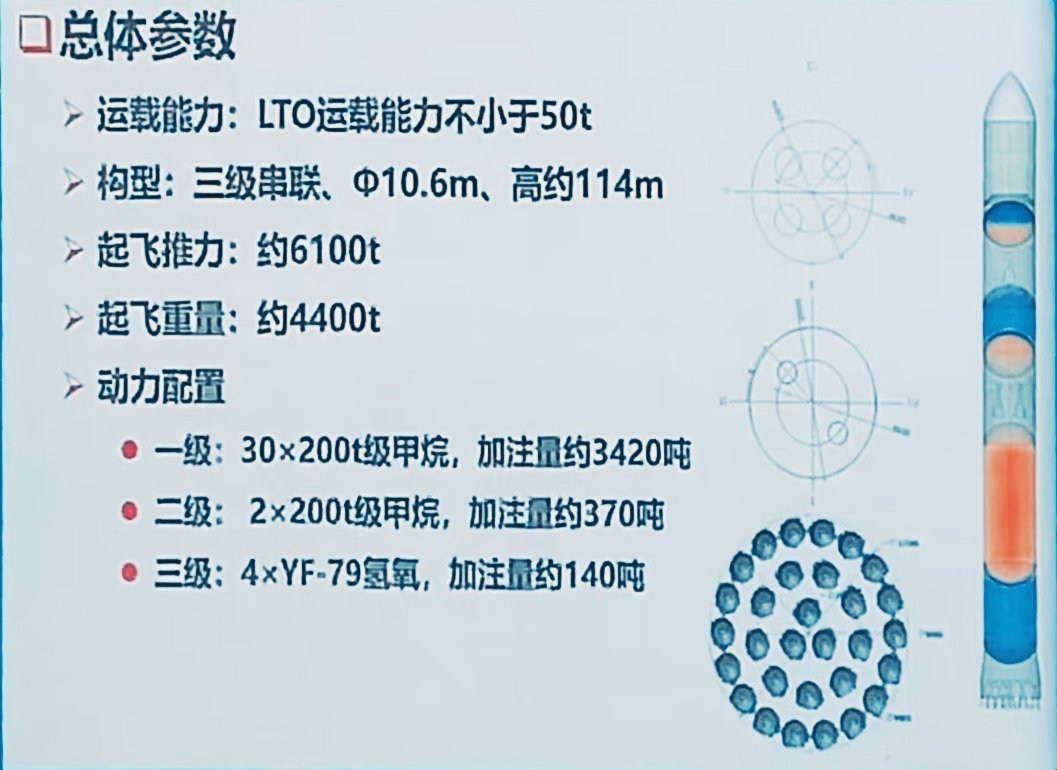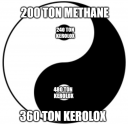Turtle Raptor?The overall design is not much different from the previous PPT. The three-stage tandem configuration has a diameter of 10.6 meters, a total length of 114 meters, a take-off mass of about 4400 tons, and a take-off thrust of about 6100 tons. 50 tons..
copying from Weibo account -
There is a small change in the power configuration: the third stage of hydrogen and oxygen is changed from one 120-ton YF-91 high-pressure supplementary combustion hydrogen-oxygen machine to four 25-ton YF-79 expansion cycle hydrogen-oxygen machines! The primary and secondary main engines are still the same. The "Turtle Raptor" 200-ton full-flow staged combustion cycle liquid oxygen methane engine is used. The former is connected in parallel with 30 units, and the latter is connected in parallel with 2 units.
In addition, the propellant filling volumes of the first, second and third stages are 3420 tons, 370 tons and 140 tons respectively.

You are using an out of date browser. It may not display this or other websites correctly.
You should upgrade or use an alternative browser.
You should upgrade or use an alternative browser.
China's Space Program Thread II
- Thread starter Blitzo
- Start date
Turtle/鳖 is used (in a memetic way) by domestic military fans as an alternative to "Chinese". Similar to how rabbit also means Chinese.Turtle Raptor?
Turtle Raptor = Chinese Raptor engines
To be fair to China, the private space sector is only in its infancy compared to the decades that the US has of both governmental and private space infrastructure built up over the cold war. It's only recently that Chinese economy and technology base has advanced to a stage that they can sustain a private space industry which we're seeing rapidly take shape in this very thread.SpaceX proved it with Falcon 9 and Falcon Heavy, so when the time came with Starship, even if it was unconventional, it wasn't directly dismissed as impossible by outsiders.
Now imagine if a random unproven European or Chinese private rocket company suddenly says that its going to build a Starship equivalent in X years. Not only will they be laughed out of the room, their investors will also chew them up for wasting their money.
It all depends if you have established technological reserves and track record to prove to the world, your government, your customers, your investors that they can trust you to deliver on your promises
SpaceX has proven this, have other private companies done it as well?
Giant heavy lift rockets like Starship while extremely capable, are only really needed for large governmental projects (space station/interplanetary), even the initial falcon 9 is heavily subsidized by the US government. We're only seeing the beginning of Chinese private enterprise leveraging industrial capacity to rapidly corner the small payload launch space, I expect much more in the next 5-10 years as the private sector experience build up and funds from Intenational customers continue to flow in.
Everything changed comparing to last seen, see the attachment below.Behold, newest LM-9 design just dropped.
Only the 3rd stage was changed from 1 * 120t YF-91 to 4 * 25t YF-79.
View attachment 111328
View attachment 111329
Source:
- 1st stage, 26 to 30
- 2nd stage, 4x120t HO to 2x200t
- 3rd stage, 1x120t HO to 4xYF-79
- Non human rated (not for initial launch) to human rated.

Last edited:
Dude 26 * 200t design was like the presentation from last summer, maybe all of us have been lost in these endless reiteration.Everything changed comparing to last seen, see the attachment below.
The last seen one was back in Feb 2023. Next we are probably gonna see them rolling back to YF135 in June then back and forth between methane and kerolox every month.

Dude 26 * 200t design was like the presentation from last summer, maybe all of us have been lost in these endless reiteration.
The last seen one was back in Feb 2023. Next we are probably gonna see them rolling back to YF135 in June then back and forth between methane and kerolox every month.
View attachment 111367
The latest iteration actually make more sense. I myself called them crazy when the older version came out. In the new design, the near earth 2 stage version does not use LH reducing the headache of fuel handling. It can be reusable. For the not so often moon mission, adding a 3rd LH stage gives the advantage of specific impulse.
Dude 26 * 200t design was like the presentation from last summer, maybe all of us have been lost in these endless reiteration.
The last seen one was back in Feb 2023. Next we are probably gonna see them rolling back to YF135 in June then back and forth between methane and kerolox every month.
View attachment 111367
The 24x 240t kerolox engine first stage design should be somewhat lower risk and faster than the 30x 200t methalox first stage design.
While the methalox design should be the future, priority should be given to getting a reusable super heavy first stage in flight test as soon as possible. As launch and recovery tests can be refined and iterated using the 240t kerolox first stage while the 200t methalox matures, they can eventually redevelop a variant of LM-9 with the 200t methalox design in the future.
Considering how different fuels kerosene and methane are, and the significant structural changes the difference in engine numbers brings that's basically advocating for the development of two first stages. Would be hard to justify financially and would lock a lot of engineering resources.The 24x 240t kerolox engine first stage design should be somewhat lower risk and faster than the 30x 200t methalox first stage design.
While the methalox design should be the future, priority should be given to getting a reusable super heavy first stage in flight test as soon as possible. As launch and recovery tests can be refined and iterated using the 240t kerolox first stage while the 200t methalox matures, they can eventually redevelop a variant of LM-9 with the 200t methalox design in the future.
Considering how different fuels kerosene and methane are, and the significant structural changes the difference in engine numbers brings that's basically advocating for the development of two first stages. Would be hard to justify financially and would lock a lot of engineering resources.
Not wrong, but the important thing is it would allow faster progression to a reusable super heavy first stage and allow faster maturation of reusability for when the 200t methalox is eventually ready.
Accelerating development to test and gain data for a super heavy first stage doing the entire launch and VTVL process is the most important part.
Of course if the goal is to only reach and sustain a peak of like, ten or twenty super heavy launches a year then I agree pursuing both kerolox and methalox first stages probably doesn't make sense.
But if the goal is to fast track reusable super heavy first stages to try and get to hundreds or even thousands of super heavy reusable launches a year, then this is somewhat small potatoes.
